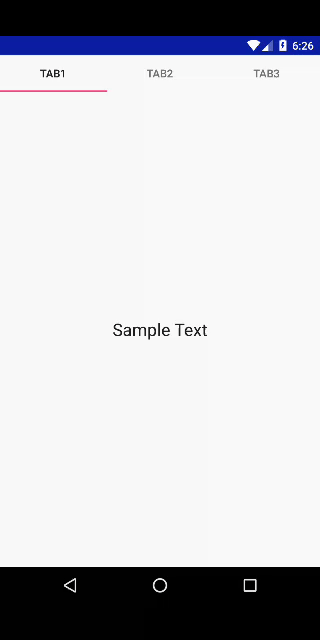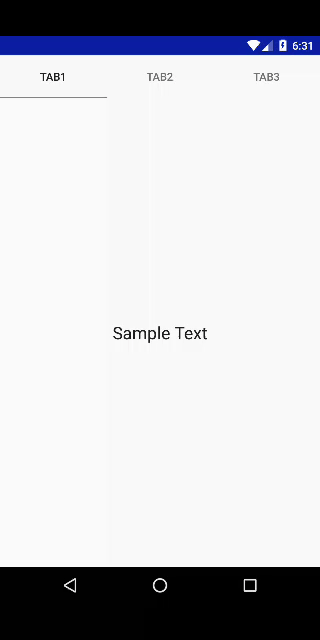TabHost with Fragments and FragmentActivity
I would suggest creating a separate fragment file for each tab. I recently did this as well, so I have outlined my code below:
Layout Files
activity_main.xml
<android.support.v4.app.FragmentTabHost
xmlns:android="http://schemas.android.com/apk/res/android"
android:id="@android:id/tabhost"
android:layout_width="match_parent"
android:layout_height="match_parent">
<LinearLayout
android:orientation="vertical"
android:layout_width="match_parent"
android:layout_height="match_parent">
<TabWidget
android:id="@android:id/tabs"
android:orientation="horizontal"
android:layout_width="match_parent"
android:layout_height="wrap_content"
android:layout_weight="0"/>
<FrameLayout
android:id="@android:id/tabcontent"
android:layout_width="0dp"
android:layout_height="0dp"
android:layout_weight="0"/>
<FrameLayout
android:id="@+id/realtabcontent"
android:layout_width="match_parent"
android:layout_height="0dp"
android:layout_weight="1"/>
</LinearLayout>
</android.support.v4.app.FragmentTabHost>
tab1_view.xml //add your respective tab layouts using this format (make sure to change string variables)
<?xml version="1.0" encoding="utf-8"?>
<LinearLayout xmlns:android="http://schemas.android.com/apk/res/android"
xmlns:tools="http://schemas.android.com/tools"
android:layout_width="match_parent"
android:layout_height="match_parent"
android:orientation="vertical"
tools:context=".DeviceFragment" >
<TextView
android:layout_width="wrap_content"
android:layout_height="wrap_content"
android:text="@string/tab1_fragment_string" />
</LinearLayout>
SRC Files
MainActivity.java //notice that in the .addTab process I only used text. You can also add icons using drawables that you would need to add to your hdpi folder. I also only created three tabs in this example.
package com.example.applicationname;
import android.os.Bundle;
import android.support.v4.app.FragmentActivity;
import android.support.v4.app.FragmentTabHost;
public class MainActivity extends FragmentActivity {
// Fragment TabHost as mTabHost
private FragmentTabHost mTabHost;
@Override
protected void onCreate(Bundle savedInstanceState) {
super.onCreate(savedInstanceState);
setContentView(R.layout.activity_main);
mTabHost = (FragmentTabHost)findViewById(android.R.id.tabhost);
mTabHost.setup(this, getSupportFragmentManager(), R.id.realtabcontent);
mTabHost.addTab(mTabHost.newTabSpec("tab1").setIndicator("Tab1"),
Tab1Fragment.class, null);
mTabHost.addTab(mTabHost.newTabSpec("tab2").setIndicator("Tab2"),
Tab2Fragment.class, null);
mTabHost.addTab(mTabHost.newTabSpec("tab3").setIndicator("Tab3"),
Tab3Fragment.class, null);
}
}
Tab1Fragment.java //once again replicate for desired number of tabs
package com.example.applicationname;
import android.os.Bundle;
import android.support.v4.app.Fragment;
import android.view.LayoutInflater;
import android.view.View;
import android.view.ViewGroup;
public class Tab1Fragment extends Fragment {
@Override
public View onCreateView(LayoutInflater inflater, ViewGroup container,
Bundle savedInstanceState) {
// Inflate the layout for this fragment
View V = inflater.inflate(R.layout.tab1_view, container, false);
return V;
}
}
Make sure that your R.java and strings.xml files are properly set up, and then your tabs should be up and running.
TabHost doesn't retains Fragment's states. So why using TabHost?
So use ViewPager with TabLayout instead.
Prons of Viewpager over Tabhost:
- ViewPager retains Fragments states. Mean Fragment will not again recreated if switched.
- Inbuilt swiping feature that gives user smoother experience.
- Less CPU consumption, because Tabhost recreates Fragment/Activity again and again when Tab is switched.
See the difference :
Using Tablayout + ViewPager (Supports swipe, retains Fragments states

Using TabHost (Doesn't support swipe, doesn't retain states)

Small Code for Tablayout + ViewPager
// find views by id
ViewPager viewPager = findViewById(R.id.viewpager);
TabLayout tabLayout = findViewById(R.id.tablayout);
// attach tablayout with viewpager
tabLayout.setupWithViewPager(viewPager);
ViewPagerAdapter adapter = new ViewPagerAdapter(getSupportFragmentManager());
// add your fragments
adapter.addFrag(new SampleFragment(), "Tab1");
adapter.addFrag(new SampleFragment(), "Tab2");
adapter.addFrag(new SampleFragment(), "Tab3");
// set adapter on viewpager
viewPager.setAdapter(adapter);
XML layout
<?xml version="1.0" encoding="utf-8"?>
<LinearLayout xmlns:android="http://schemas.android.com/apk/res/android"
android:layout_width="match_parent"
android:layout_height="match_parent"
android:orientation="vertical">
<com.google.android.material.tabs.TabLayout
android:id="@+id/tablayout"
android:layout_width="match_parent"
android:layout_height="wrap_content" />
<androidx.viewpager.widget.ViewPager
android:id="@+id/viewpager"
android:layout_width="match_parent"
android:layout_height="0dp"
android:layout_weight="1" />
</LinearLayout>
Note If you are not using AndroidX yet, you need to change following in layout.
- Change
com.google.android.material.tabs.TabLayouttoandroid.support.design.widget.TabLayout - Chagne
androidx.viewpager.widget.ViewPagertoandroid.support.v4.view.ViewPager
But I'll strongly recommend to migrate to AndroidX, see @this answer to understand why.
And this is common ViewPagerAdapter for all your Viewpager in app.
public class ViewPagerAdapter extends FragmentStatePagerAdapter {
private final List<Fragment> mFragmentList = new ArrayList<>();
private final List<String> mFragmentTitleList = new ArrayList<>();
public ViewPagerAdapter(FragmentManager manager) {
super(manager);
}
@Override
public Fragment getItem(int position) {
return mFragmentList.get(position);
}
@Override
public int getCount() {
return mFragmentList.size();
}
@Override
public CharSequence getPageTitle(int position) {
return mFragmentTitleList.get(position);
}
public void addFrag(Fragment fragment) {
mFragmentList.add(fragment);
mFragmentTitleList.add("");
}
public void addFrag(Fragment fragment, String title) {
mFragmentList.add(fragment);
mFragmentTitleList.add(title);
}
}
Important Related Links
- Difference between getSupportFragmentManager() and getChildFragmentManager()?
- getSupportFragmentManager() versus getFragmentManager() in android 3.0+
- Difference between FragmentPagerAdapter and FragmentStatePagerAdapter